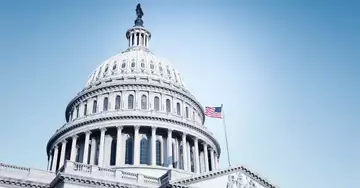The week of the terraUSD (UST) collapse was one of the most painful weeks in crypto history - and one that we will remember for a long time. It wreaked havoc on the crypto market, resulting in billions of dollars in lost value. And while Washington, D.C., is rightly debating next steps, a smart, thoughtful conversation about potential regulation is critical.
Stablecoins are an important innovation that offers many benefits for users and a competitive advantage for the United States. Stablecoins improve the efficiency of payments and remittances, lowering costs and speeding up processing for businesses and consumers. They make the financial system more inclusive by providing open access to anyone, anywhere, regardless of their origin or economic status. They can also advance U.S. geopolitical interests by strengthening the dollar's global dominance against attempts by our adversaries - such as China and Russia - to undermine U.S. leadership in the financial system.
Jake Chervinsky is director of policy at the Blockchain Association.
As the name implies, stablecoins are meant to be stable and reliable. In general, there are two broad categories of stablecoins: custodial and decentralized.
Custodied stablecoins are issued by a centralized custodian and are backed by collateral at a bank or other institution. They are usually fully collateralized: The issuer holds one dollar in the bank for every dollar of stablecoins it issues. Custodied Stablecoins account for the vast majority of total Stablecoin volume and are very stable and reliable, provided the issuer is trustworthy and transparent.
Decentralized stablecoins were developed to address the fact that not all issuers are trustworthy or transparent. Their goal - much like the public blockchains that enable them - is to eliminate reliance on trusted intermediaries in the financial system, who often do more harm than good. They achieve this goal by producing stablecoins that seek to maintain their attachment to dollars through the operation of autonomous code rather than dependence on a central issuer. Rather than being backed by dollars in a bank, decentralized stablecoins are typically backed by other digital assets held programmatically as collateral on the blockchain.
Although custodial and decentralized stablecoins use different models, neither is fundamentally better or worse than the other. Both have unique characteristics-both benefits and risks-that combine to create a robust, competitive market characterized by consumer choice. We should support responsible innovation in both categories.
Unfortunately, UST was a category unto itself, relying solely on an algorithmic mechanism to maintain price stability without any collateral-a risky model that many predicted would fail.
So how should policymakers respond after this month's events?
First, as U.S. Treasury Secretary Janet Yellen indicated to Congress on May 12, policymakers should follow the process laid out in President Joe Biden's Executive Order (EO) earlier this year. The EO - which directs federal agencies to study cryptocurrencies and report on regulatory priorities and solutions - provides clear guidance on how to proceed thoughtfully in regulating stablecoins. This work is important and will continue. With input from industry stakeholders and trade groups like my employer, the Blockchain Association, policymakers should develop a comprehensive understanding of the stablecoin space and the key differences between various stablecoin concepts. This is a necessary first step before effective regulation can be formulated.
Second, a bipartisan consensus should be reached in Congress. In the immediate aftermath of the UST collapse, Congress has been entrenched on both sides of the aisle on this issue. But as my colleague Kristin Smith wrote recently, the crypto economy is too big for partisan politics. We need politicians on both sides of the aisle to work together to find the best regulatory approach for cryptocurrencies. As the President's Working Group on Financial Markets (PWG) recommended in its report on stablecoins last year, a regulatory solution must come from Congress - not regulators.
Third, new regulations should be enacted that are fit for purpose. These measures must be balanced and take into account the indispensability of dollar-dominated stablecoins to U.S. financial security in the decades ahead. We need tailored regulatory frameworks that take into account the specific benefits and risks of stablecoins. For custodial stablecoins, Senator Pat Toomey (R-Pa.) and Representative Josh Gottheimer (D-N.J.) have separately proposed tailored frameworks - great examples of smart regulatory approaches from both sides of the aisle in the Senate and House. In time, we can develop similarly well-tailored frameworks for decentralized stablecoins.
Stablecoins present too great an opportunity for us to risk mishandling them politically. The U.S. is in an international race for Web 3. It is time for strategic thinking and thoughtful action. The future of the U.S. as the center of global crypto innovation is at stake.

